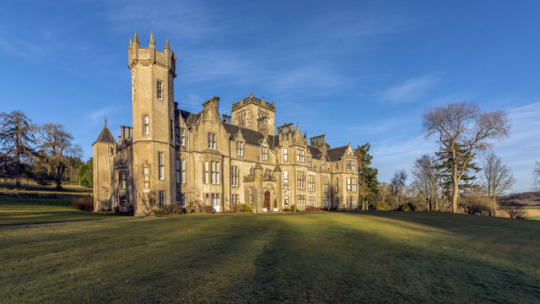Photo


FORGLEN HOUSE SITUATED ON THE FORGLEN ESTATE, IN THE PARISH OF FORGLEN, ABERDEENSHIRE.
0 notes
Photo









Castle's Rock - 05 April 2018 Inchdrewer Castle Banff, Aberdeenshire, Scotland.
Inchdrewer Castle is a 16th-century tower house in the parish of Banff, Aberdeenshire, in the northeast of Scotland. Situated on a slight rise 3.5 miles (5.6 km) southwest of Banff, it looks across to Banff Bay. Originally owned by the Currour family, it was purchased by the Ogilvies of Dunlugas in 1557 and became their main family seat. The Ogilvies were staunch Royalists, which resulted in the castle coming under attack from the Covenanters in 1640.
George Ogilvy, 3rd Lord Banff was murdered in 1713 and his body hidden inside the castle, which was then set on fire. The castle came under siege again in 1746, during the Jacobite rising of 1745–46. At the start of the 19th century, following the death of the 8th Lord Banff, the property was inherited by the Abercromby of Birkenbog family, who leased it to a tenant. It became uninhabited after 1836 and the structure deteriorated.
Over the following century the neglect continued until some basic external renovation work was undertaken between 1965 and 1971, making the structure wind and water tight, although it remained unoccupied. The castle was again abandoned and left unmaintained. The condition of the building further declined, becoming derelict. It was in a ruinous state when marketed for sale in April 2013 after the death of Count Robin Mirrlees, who had owned it for about fifty years.
At the end of that year it was purchased by the former model Olga Roh, who said she intended to restore it. Modern day reports suggest that the spirit of the 3rd Lord Banff and that of a white dog haunt the castle, which is classifiedThe castle's exact construction date is unknown, but it was some time in the early to mid 16th century, during the reign of either James IV or James V. Various spellings are used: Inch Druar (or Inchdruar as one word); Inchdruer; Inchdrewir; or Inchdrewr. Originally owned by the Curror (Currour) family, in 1557 it was purchased by Walter Ogilvy of Dunlugas (1509–58), and became the main family seat. James Currour was a notary in Banff and is linked with several of Dunlugas' contracts and witnessing leases.During the late 16th century the Dunlugas Ogilvies undertook re-furbishment and extension work, including the addition of courtyard buildings and a distinctive circular tower that incorporated the hall into its first storey. An act recording the lands in favour of George Ogilvy was ratified by King Charles I in late June 1633.
George was the son of Walter Ogilvy, and an ardent Royalist and supporter of the king against the Covenanters. Inchdrewer Castle was left in ruins after being attacked by Covenanter forces led by General Robert Monro in 1640; another of the family properties, a town house, was also devastated. George Ogilvy was appointed a peer in 1642, becoming the first Lord Banff.George Ogilvy, 3rd Lord Banff, inherited the property when his father, the 2nd Lord Banff, died on 10 September 1668. He was murdered in 1713 and the castle destroyed by fire; his body had been concealed inside.
Restoration work was once more undertaken.The castle came under attack by troops led by the Duke of Cumberland in 1746 in the course of the Jacobite rebellion. Yet more restoration work was carried out during the later part of the century.When William Ogilvy, 8th Lord Banff, died on 4 June 1803, the estate was inherited by his sister Jean (sometimes named Jane), who had married George Abercromby (Abercrombie) of Birkenbog.
Her son, Sir Robert Abercromby succeeded her. Sir Robert was appointed member of Parliament for the Banff constituency in 1812 but four years later claimed financial difficulties prevented him seeking re-election. In 1820 he asked George IV to allow the Banff peerage, which had become dormant or extinct when the 8th Lord Banff died, to continue by declaring his mother Baroness Banff, or granting him the title of Lord Banff, but the request was denied.The main residence of the Abercromby's was at Forglen House, Turriff. The castle was in a sufficient state of repair to be leased to tenants until 1836.
MacGibbon and Ross refer to the castle as being in the ownership of Sir R. J. Abercromby of Birkenbog when writing about it in their architectural book published in 1887. The ground-floor plan given in the book shows two parts of the building as being "ruinous".The castle was abandoned at the beginning of the 20th century, and it soon became dilapidated
0 notes
Photo

Forglen House
251 notes
·
View notes



